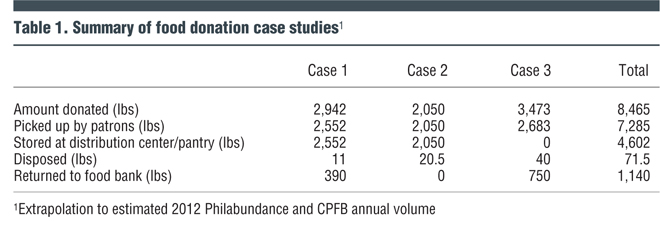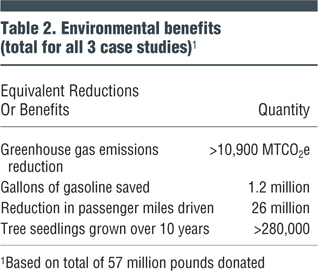Assessment of environmental benefits and efficiency of local and regional food donation events shows big win for all participants. The challenge is how to grow the ranks of surplus food donors.
Steven M. Finn, Tom O’Donnell and Matthew Walls
BioCycle September 2014
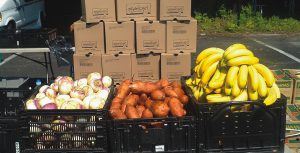
Philabundance, a large regional food bank serving the Philadelphia (PA) region, holds “Fresh For All” distribution events each week to distribute fresh produce to those in need.
Food recovery programs in the U.S. vary in size and form, but all contribute environmental, social and economic benefits through diversion of excess food from landfills. The U.S. Environmental Protection Agency (EPA) actively supports food recovery initiatives and has created the Food Recovery Challenge (FRC) as part of the Sustainable Materials Management Program to reduce the environmental impact of materials — including excess food — through their respective life cycles.
The EPA recently engaged ResponsEcology, a Philadelphia-based consulting firm, to assess the environmental benefits and efficiency of local and regional food donation events involving FRC participants (Food Recovery Assessment, 2013). Efficiency in this case refers to the percentage of donated material that is ultimately received by people in need versus being discarded. The case studies show high efficiency in food redistribution and suggest multiple opportunities for social, economic and environmental gain — including significant greenhouse gas (GHG) emission reductions relative to landfill disposal.
Abundance Of Food Waste And Losses
Food waste is one of the most critical problems facing the world today, and it is beginning to garner increased attention. Global and domestic statistics on the extent of food waste are truly staggering. A 2008 report by the Stockholm International Water Institute noted that global food losses and wastage could be as high as 50 percent from field to fork (Lundqvist, et al., 2008). A study by the Institution of Mechanical Engineers noted that of the 4.4 billion tons of food produced annually, 1.3 billion to 2.2 billion tons are not consumed by humans (Fox, 2013). FAO noted that in U.S. dollars, food losses and waste total nearly one trillion dollars annually (FAO, 2013).
In the U.S., food waste is excessive and the trend is worsening. A 1977 study estimated that 20 percent of food produced for human consumption was wasted (USDA, 1977). Twenty years later, another study estimated U.S. food losses at 27 percent of the food available for human consumption (Kantor, et al., 1997). A 2010 USDA study noted that 31 percent of the food supply at the retail and consumer levels was not eaten (Buzby, et al., 2014), while a 2012 report by the Natural Resources Defense Council pegged food waste in the U.S. from farm to fork at 40 percent (Gunders, 2012).
The U.S. is not alone among industrialized nations in this regard. For example, a 2008 report by the Waste Resources Action Programme (WRAP) noted that households in the United Kingdom waste about 33 percent of purchases, and that nearly 25 percent of avoidable food waste was discarded in a whole or unopened state (WRAP, 2008).
Such alarming waste figures indicate a clear disconnect regarding the value placed on food (and the resources that go into producing it) and its true value. Coupled with the current state of world hunger, the need to feed two billion additional global citizens by 2050, and increasing competition for scarce resources, that disconnect becomes even more of a concern. It also represents great opportunity for growers, food service providers, corporations in the food and recycling sectors and municipalities.
A clear need exists for responsible surplus food management that captures and redirects excess food to higher value purposes other than landfills. The EPA provides an effective hierarchy to guide individuals and organizations in managing food resources for higher value. Beyond source reduction, those options range from feeding people and livestock to industrial uses and composting (EPA, 2014a). The hierarchy is a useful starting point to embrace the opportunity in excess food.

With nearly one in six Americans experiencing food insecurity, capturing and distributing excess food — instead of throwing it away — requires mindset change throughout the food supply chain.
Waste Or Excess? Practice Of Food Recovery
The traditional view of unsold food (or food nearing the end of its shelf life) at farms and retail establishments in the U.S. has been one of “waste” — a seemingly necessary cost of doing business that needed to be discarded as quickly and inexpensively as possible to avoid disruption to future operations. Often, little thought was given to actively trying to divert that “excess” to a higher purpose. Disposing of food in landfills has been too easy, and relatively inexpensive, for generations. That mindset has been bred into most business operations, with the result that EPA estimated that 96 percent of food waste generated in the U.S. in 2011 was thrown into landfills or incinerators (EPA, 2014b).
There are myriad causes of losses and waste in the U.S. food supply chain. On the farm, overproduction, imperfect weather, pests, machinery damage and unanticipated market conditions lead to losses. Blemishes and irregular sizes lead to even more. Improper handling and storage (particularly regarding temperature) and package damage lead to losses in transit. At the retail level, overstocking, compliance with confusing sell-by/use-by labeling, and intolerance for less-than-perfect produce leads to considerable waste (see Intermarche “Inglorious Fruits and Vegetables”). In restaurants, excessive portions and over-preparation lead to food discards, while in the home, insufficient planning and unnecessary purchases result in additional food waste (Kantor, et al., 1997).
While the traditional approach to food recovery has involved several regional food banks supporting a host of food pantries and shelters, many organizations are implementing creative solutions to capture and redistribute excess food. One example is Food Donation Connection, which recovers food through partnerships with multiple restaurant chains. Many of these operations are deliberately small, such as Anna Chan (the Lemon Lady) — an urban gleaner in northern California, and Willing Hands — a highly efficient produce recovery operation on the New Hampshire/Vermont border. Others, such as the Food Recovery Network, focus on simplicity — drawing on concerned college students in matching excess food resources with hungry people in local communities. Some operations are larger and harvest entire fields of produce for those in need, such as Ag Against Hunger in California. Motivated individuals are developing alternative concepts to reduce food waste and help fight hunger, such as Doug Rauch’s “Daily Table” concept in Boston. Rauch’s initiative involves setting up a storefront in a low-income neighborhood that will sell still edible food donated by supermarkets at very low prices. All of these organizations are motivated by the desire to provide high quality food to individuals who are food insecure.
Benefits, Challenges Of Surplus Food Management
As recycling industry executives and corporate sustainability managers are realizing, there are numerous social, environmental and economic benefits to surplus food recovery programs that mesh well with organizations pursuing triple bottom line objectives.
Perhaps most important is the social aspect: the ability to feed hungry people with surplus food that would otherwise go to waste. With nearly 50 million (about one in six) Americans currently experiencing food insecurity according to Feeding America — many of them children and seniors — a strong moral argument can be made for the need to capture and redistribute excess food (Feeding America, 2014). Environmental benefits of food recovery programs abound, including reduction of GHG emissions in the form of methane gas from decomposing food and impacts from landfill leachate.
Food recovery programs result in societal economic benefits due to: 1) Reduction of costs associated with the aforementioned externalities of landfilling food waste; 2) Elimination of costs and resource consumption associated with the production, processing and distribution of food that is not consumed; and 3) Routing of the high quality calories found in fruit, vegetable, meat and dairy discards to food insecure individuals, which can help reduce the rapidly rising health care costs associated with poor nutrition and obesity. In addition, recycling programs create jobs. The Tellus Institute estimates that roughly 2.5 jobs are created for every 1,000 tons of material collected for recycling or composting (Goldstein, 2011).
Organizations engaging in food recovery programs achieve good publicity in the community by helping to feed the hungry while reducing their environmental footprint. In addition to the landfill disposal factors cited above, food recovery, in many cases, uses fewer vehicle miles than landfilling, thus reducing the environmental impacts of transportation. Donor organizations also improve financial results through tax deductions and reduced trash disposal expenses. Further, improved morale results from the creation of an inspired workforce. Today’s employees desire more than just a paycheck; they want to be part of something larger at work. Food recovery programs, perhaps coupled with company-supported volunteer hours at local food banks and pantries, generate positive feelings toward the organization and help attract and retain talent. Such programs also inspire creativity that leads to financial gains in other areas of company operations as employees seek ways to reduce waste elsewhere.
In the continual search for food supplies, food banks and pantries seek partnerships with all types of organizations throughout the food supply chain — from farmers to retailers and restaurants to food service companies. While the benefits of food recovery are clear, establishing food recovery partnerships is by no means easy. Barriers must be overcome to launch such programs and to ensure their durability.
A key obstacle is change itself. Change is rarely easy, and moving an organization from an established method of handling excess food (which nearly always involves hauling to a landfill) is simply hard to do. Second, beyond relationship building, food recovery operations require equipment (trucks, refrigerators, freezers and storage facilities) along with staff and logistical capabilities. Such start-up costs, in a sector known for limited resources, can be significant. Third, fear of liability is a serious barrier to food donation programs. Despite legal protection from legislation such as the Bill Emerson Good Samaritan Act, food sector organizations often shy away from donations due to the fear of reputational risk that could accompany a publicized claim of sickness associated with a food donation — whether real or fraudulent. Taken together, these issues explain why only a sliver of all excess food in the U.S. is put to good use rather than being discarded.
Additionally, concerns over the reliability of service providers often prevent establishment of food donation programs. Farmers, for example, have little time during the majority of the year to engage in discussions with potential food recipients. If a food bank representative does manage to get a farmer to agree to a donation program, the recipient organization must demonstrate exceptional reliability, meeting designated pick-up times without exception. Less than perfect operational performance will doom the program as farmers lack the time and resources to deal with the inefficiency. The recipient must also efficiently handle required paperwork and provide the farmer with appropriate documentation for tax purposes in a timely manner.
Relationships with retail establishments require a similar high level of reliability. Retailers have limited space and limited labor to handle excess food with a short shelf life. They accept significant levels of waste (particularly with fresh produce items) in order to provide customers with a highly attractive and convenient shopping experience on a 24/7 basis. As a result, they are “wired” to quickly dispose of excess food to avoid disruption to service operations. If a food bank fails to provide exceptional pick-up service once a donor relationship is established, that relationship will quickly implode.
Excess Food: Case Studies In Recovery, Distribution
Achieving the benefits of food recovery at greater scale involves embracing food as a valuable resource. This requires mindset change throughout the food supply chain among consumers, retailers, recyclers and corporate leaders. Terminology is important. We should move away from “food waste” to “excess food” and “surplus food” — the latter terms imply value (and correctly so). Consumers in industrialized countries like the U.S. tend to associate food with abundance; we should think about our food and the resources that go into producing it in terms of scarcity. Feeding another two billion people by 2050 requires such a change in thinking. As McKinsey notes in a landmark report, global resources are increasingly scarce and increasingly linked. Three billion additional middle class consumers will come on line in the next two decades, putting additional strain on limited global resources. As those resources grow more scarce, extracting them is more expensive — and environmental challenges such as drought have the potential to further limit production (Dobbs, 2011). These points have critical relevance for food production.
As the following three case studies indicate, opportunities to match excess food with hungry people abound at the local level, offering the benefits of building community by mitigating hunger and reducing environmental impact. Recyclers who integrate surplus food donation programs into operations can create value for customers and strengthen existing business relationships before legislation mandates organics recycling. Opportunities to feed livestock, produce power and produce compost also exist, offering the environmentally attractive option of utilizing outputs from one process as inputs to another.
Case Study 1: Central Pennsylvania Food Bank/Northern Dauphin Food Pantry
The Central Pennsylvania Food Bank (CPFB) operates a large, modern facility in an urban setting in Harrisburg. CPFB is a regional food bank in the Feeding America network that handles between 2.5 and 3 million pounds of food per month. The organization distributes food through more than 600 partner agencies, impacting more than 55,000 individuals per month through a variety of on-site and off-site programs. Like other regional food banks, CPFB has been facing intense demand for food by a growing constituent base in the wake of the economic downturn. No longer just a safety net, the food bank is now the primary source of food for many individuals, according to Brad Peterson, Director of Communications. In such an environment, the value of excess food is clear.
CPFB also recognizes the value of partnerships, working with large retailers as well as growers in the region to acquire food donations while also managing tens of thousands of volunteer hours annually. In fulfilling its mission of capturing and redistributing excess food to the hungry, CPFB also places much attention on nutrition. The facility has a new demonstration kitchen to provide nutrition education and life skills training to food insecure individuals. For the small amount of donated food that goes to waste, CPFB either transfers it to a local farmer for animal feed or sends it to a waste-to-energy facility.
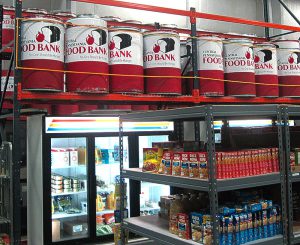
The Central Pennsylvania Food Bank handles between 2.5 and 3 million pounds of food per month. It supports the Northern Dauphin County Food Pantry, which distributes food in a “choice” setting versus handing out preassembled boxes of food.
CPFB supports the Northern Dauphin Food Pantry, a small (1,000 square foot) facility in Elizabethville, 30 miles north of Harrisburg. The Pantry focuses on providing rural constituents with nutritious food in a “choice” setting, where recipients can choose the food items they desire rather than being handed a preassembled box of food. The choice aspect minimizes waste, and recipients schedule half-hour visits where they can make needed food selections in a private, respectful setting. Pantry employees closely manage food supplies through judicious ordering and focus on efficient operations amid tight space constraints. Items nearing expiration dates are placed in “free choice” stations to prevent waste. Moldy bread is given to a local pig farmer for animal feed. The facility is highly efficient, with just one percent of incoming donations going to waste in an average week.
The Pantry benefits from a strong local partnership with a supermarket (located just across the street) that provides weekly donations. The local relationship benefits both parties through minimal distribution costs. Northern Dauphin patrons receive a regular supply of needed food, and the donating supermarket is able to clear its facility of perishable (or overstocked) excess food at low cost while creating goodwill among community members as well as employees, who are clearly energized by the program.
Case Study 2: Philabundance/Feast of Justice
Like the CPFB, Philabundance is a large, modern regional food bank serving the Philadelphia region (eastern Pennsylvania and southern New Jersey). Philabundance supports a number of food pantries through its Grocers Against Hunger program, in which meat, dry goods, bakery items, dairy products and fresh produce are picked up from participating food retailers and distributed to pantries in the area. One recipient is the Feast of Justice Pantry in northeast Philadelphia, which seeks to mitigate the problems of food insecurity. The Pantry serves about 1,500 families, many of whom are suddenly experiencing food insecurity in spite of working full or part-time jobs.
Feast of Justice is also a “choice” facility designed to emulate a supermarket experience as closely as possible for its patrons — who are referred to as “guests” by staff members. It is a busy operation that receives and distributes food daily while building a stronger community through its work. Feast of Justice provides emergency food boxes as well as meals for homebound individuals that are prepared in its kitchen facility. A “feast day” is held once a month in which anyone in need can come in for a hot meal and fellowship. Again, the value of food resources is quite clear.
Refrigerator and freezer storage help to extend the life of donated food, and Pantry volunteers are permitted to take home food that hits its expiration date to reduce discards. As a result, food waste is minimal — similar to the one percent figure noted at Northern Dauphin Pantry.
Case Study 3: Philabundance “Fresh For All”
On a weekly basis throughout the year, Philabundance holds “Fresh For All” distribution events at various locations in the Delaware Valley. The goal is to distribute nutritious fresh produce to those in need. Volunteers set up a distribution line and advise patrons on how much of each item they can select. There is a “choice” element here as well; patrons can select the items that they desire rather than being handed a standard box of items (some of which they might not consume).
There is great demand for this food. Individuals often line up for hours prior to the events in order to be one of the first through the line. Weather is a concern as recipients — many of whom are senior citizens and children — are exposed to the elements. Unlike the Pantry experiences, there is no anonymity at such events — individuals form a line with others from the area. The value of food and the importance of minimizing food waste were again clearly apparent at a Fresh For All event observed by ResponsEcology (coauthors of this article). Only a small amount of blemished produce (just over one percent) was lost over the course of the distribution and was sent to a composting facility.
Quantifying Environmental Benefits
Table 1 summarizes the surplus food management for the case studies. The three case studies illustrate the significant need for food recovery programs to serve the hungry and some of the logistical capabilities and “people skills” required to do so. They also reveal the efficiency of food recovery operations and provide a clear lesson: when excess food is highly valued, little goes to waste. Last, they demonstrate the environmental benefit from diverting excess food from landfills to other uses. EPA’s WARM model (EPA, 2014c) was applied to the estimated combined 2012 food donations distributed by Philabundance and Central Pennsylvania Food Bank to estimate the positive impact on climate change.
Table 2 quantifies the environmental benefits (based on 57 million pounds donated). Donating 57 million pounds of food avoids more than 10,900 metric tons of landfill greenhouse gas emissions. This has an equivalent impact of reducing consumption of gasoline by more than 1.2 million gallons or of reducing the number of average passenger vehicle miles driven by more than 26 million. Alternatively, it reflects the amount of carbon sequestered by over 280,000 tree seedlings grown for over ten years.
Viewed on a long-term basis, food recovery programs exert downward pressure on food purchases by donors, which accomplish the waste prevention objectives of EPA’s Food Recovery Challenge. As a result, the positive impact of the calculations above can be increased by as much as 45 percent when source reduction is taken into account. Food donation, not currently directly calculated in the WARM model, is a form of waste prevention that has a significant, positive impact on GHG emission reduction goals when included in a recycling and composting program.
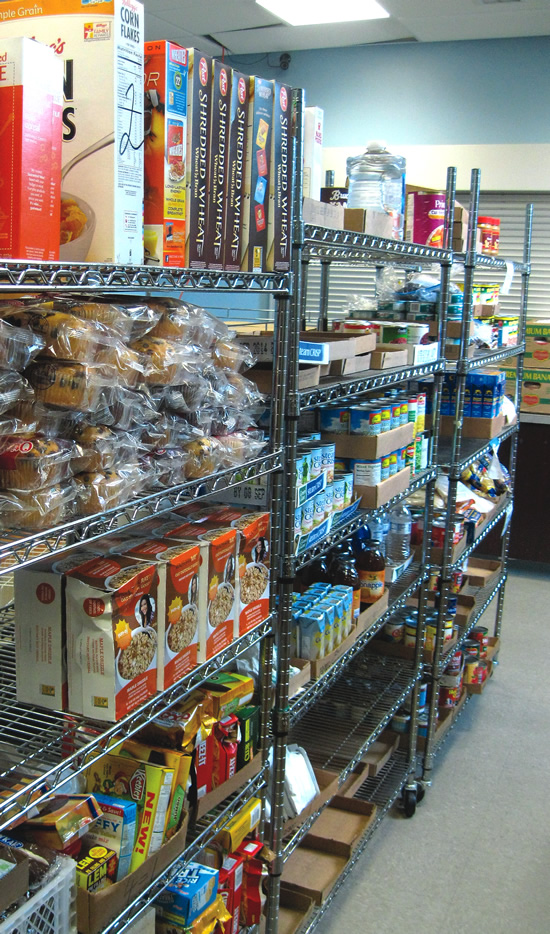
Philabundance’s Feast of Justice Pantry, also a “choice” facility, services about 1,500 families, many of whom are suddenly experiencing food insecurity in spite of working full or part-time jobs.
Takeaways: Opportunities And Benefits
The key takeaway for corporate social responsibility (CSR) and sustainability leaders in the public and private sectors, and for executives in the recycling sector, is one of opportunity. Levels of food waste in the U.S. are extensive. Food insecurity and obesity due to poor nutrition are rising. Discarded food in landfills does additional harm to the environment in the form of GHG emissions. Viewed together, these themes suggest powerful opportunities for food recovery partnerships.
Yet of the millions of viable businesses in the U.S. with some level of excess food, only a few hundred currently participate in EPA’s Food Recovery Challenge. Corporate sustainability leaders should embrace this opportunity and partner with food banks and retailers to redirect excess food to higher value uses and tap into the triple bottom line. Demonstrating a leading role in this area will help to attract, and retain, great personnel.
Recycling industry leaders can assist with this transition and build relationships, develop partnerships, establish infrastructure, create goodwill, and develop business models which redirect excess food for human consumption, livestock feed, industrial uses and power generation and compost.
Forward-thinking recycling industry and food sector leaders who participate in developing organics processing infrastructure while simultaneously building donor relationships will achieve competitive advantage. Rocco D’Antonio of Organic Diversion, a New Jersey-based food and organics recycler, recognizes the opportunity. Organic Diversion follows the EPA Food Recovery hierarchy and explains how food donations, recycling and composting work together to create value for customers through reduced operating costs while also helping people and planet and providing volume for recyclers. He notes that there is so much excess food going to waste that “integrating donations with commercial composting or digestion is the only way to zero waste solutions.”
Longer term, the continued population shift to urban centers will increase density and reduce food recovery costs while increasing volume for recyclers and digesters. Population growth, increasing pressure on resources, and increased focus on sustainable operations will lead to heightened recognition of the value of food resources, as well as continued opportunity for food recovery and recycling partnerships.
Steven M. Finn is cofounder & Managing Director at ResponsEcology Consulting and Affiliated Faculty in Organizational Dynamics at the University of Pennsylvania. Thomas O’Donnell, PhD is a sustainability coordinator at the U.S. Environmental Protection Agency (NAHE), Region 3 and professor of sustainability at Philadelphia University and Cabrini College. Matthew P. Walls is a global executive in the biopharmaceutical industry and cofounder & Managing Director at ResponsEcology Consulting.
Disclaimer: Any views expressed in this report do not necessarily represent those of the United States government nor the Environmental Protection Agency. Mention of trade names or commercial products does not constitute endorsement or recommendation for use.
